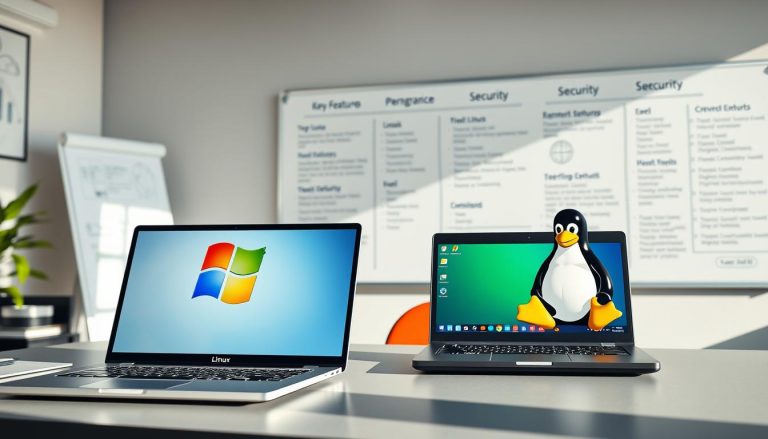Welcome to my guide on CentOS, where I will provide an overview and explanation of this open-source project. CentOS is a popular Linux distribution known for its stability, security features, and compatibility with the enterprise Linux ecosystem. Whether you’re new to CentOS or looking for a detailed guide, you’ve come to the right place.
CentOS offers two distinct versions: CentOS Stream and CentOS Linux. CentOS Stream serves as the development platform for upcoming releases of Red Hat Enterprise Linux, while CentOS Linux is derived from the source code released by Red Hat. With its growing community of contributors, CentOS provides a stable and secure operating system that is widely used in various industries.
Key Takeaways:
- CentOS is an open-source project offering two Linux distributions: CentOS Stream and CentOS Linux.
- CentOS provides stability, security, and compatibility with the enterprise Linux ecosystem.
- CentOS Stream serves as the development platform for upcoming releases of Red Hat Enterprise Linux.
- CentOS Linux is derived from the source code released by Red Hat.
- CentOS is widely used and offers features such as great security, regular updates, stability, and multiple management platform options.
The Difference between CentOS Stream and CentOS Linux
CentOS Stream and CentOS Linux are two versions of CentOS with some key differences. CentOS Stream serves as the upstream development platform for Red Hat Enterprise Linux, allowing community members to contribute and test code that could be included in the next minor release of Red Hat Enterprise Linux. In contrast, CentOS Linux is derived from the source code released by Red Hat and does not have a contribution model.
Both versions offer stability, security features, and compatibility with the enterprise Linux ecosystem. CentOS Stream provides a continuous stream of updates and innovations, making it ideal for users who want to be at the forefront of technology. It allows for early access to new features and bug fixes, enabling users to provide feedback and shape the direction of Red Hat Enterprise Linux.
On the other hand, CentOS Linux is more focused on providing a stable and secure operating system. It is suitable for users who prioritize reliability and long-term support. CentOS Linux follows a traditional release model, ensuring that updates and patches are thoroughly tested before being made available to users. This approach guarantees a robust and dependable platform for mission-critical applications.
Feature comparison between CentOS Stream and CentOS Linux:
| Features | CentOS Stream | CentOS Linux |
|---|---|---|
| Contribution Model | Community-driven | Derived from Red Hat |
| Release Model | Continuous stream of updates | Traditional release model |
| Focus | Early access to new features | Stability and long-term support |
| Suitability | Users seeking cutting-edge technology | Users requiring a stable and secure platform |
Overall, the choice between CentOS Stream and CentOS Linux depends on the specific needs and preferences of the user or organization. Both versions offer reliable and robust operating systems, with CentOS Stream providing a more forward-looking and community-driven experience, while CentOS Linux focuses on stability and longevity.
Benefits of Using CentOS
CentOS offers a wide range of benefits that make it a popular choice for various industries and users. Let’s explore some of the key advantages of using CentOS:
1. Great Security: CentOS prioritizes security and provides features such as SELinux, which reduces vulnerabilities to privilege escalation attacks. With CentOS, you can rest assured that your operating system is equipped with robust security measures.
2. Extended Support: CentOS offers long-term support for major versions, with a ten-year lifecycle and regular security updates. This stability and support are crucial for businesses that require reliable platforms for their applications.
3. Excellent Package Management: CentOS uses the YUM package manager, which simplifies package installation, customization, and configuration. The extensive range of available packages makes it easy to customize your CentOS installation based on your specific needs.
4. Documentation and Community Support: CentOS has a thriving community-driven support system. There is a wealth of documentation, forums, and user groups where you can find answers to your questions and get assistance from experienced users and developers.
5. Multiple Management Platform Options: CentOS supports various management and control panel platforms, providing users with flexibility and ease of use. Whether you prefer cPanel, Webmin, or another management interface, CentOS has options to suit your preferences.
CentOS and Red Hat Enterprise Linux
CentOS and Red Hat Enterprise Linux (RHEL) are closely related operating systems that share many similarities. CentOS is derived from the source code released by Red Hat and offers a free and open-source alternative to RHEL. Both operating systems provide the same functionality, compatibility, and bug fixes, making them suitable choices for individuals and organizations.
One key difference between CentOS and RHEL is the support model. RHEL is supported by a dedicated team of full-time engineers and staff, ensuring prompt and reliable assistance for commercial users. On the other hand, CentOS support is provided by the community, which relies on voluntary contributions and community-driven forums for assistance.
Another difference lies in the licensing. While CentOS is free to use, RHEL requires a subscription for commercial use. However, Red Hat offers programs that provide no-cost RHEL subscriptions for qualifying individuals and organizations, making it accessible to a wider range of users.
| Comparison | CentOS | Red Hat Enterprise Linux |
|---|---|---|
| Support Model | Community-driven | Professional support by Red Hat |
| Commercial Licensing | Free | Subscription-based |
| Updates and Security Patches | Community-driven | Regular updates and security patches provided by Red Hat |
| Enterprise-level Features | Yes | Yes |
Ultimately, the choice between CentOS and RHEL depends on the specific needs and requirements of the user. CentOS is a viable option for those seeking a free and community-driven operating system, while RHEL provides professional support and additional enterprise-level features for commercial users.
CentOS Sundown and Migration Options
The future of CentOS Linux is undergoing a significant shift, and users of CentOS Linux 7 need to be aware of the upcoming changes. On June 30, 2024, CentOS Linux 7 will reach its End of Life (EOL). This means that users will no longer receive updates, bug fixes, or security patches for CentOS Linux 7. As a result, it is essential for CentOS Linux 7 users to choose a migration path to continue receiving support and updates for their operating system.
One option for migration is CentOS Stream, which will serve as the open-source development platform for upcoming releases of Red Hat Enterprise Linux minor versions. CentOS Stream allows users to stay closely aligned with the latest changes and developments in the Red Hat ecosystem. Migrating from CentOS Linux 8 to CentOS Stream 8 can be achieved using specific commands, ensuring a smooth transition without significant disruptions to your current system.
However, CentOS Stream may not be the ideal choice for all users. Fortunately, there are alternative operating systems available for migration. One popular option is Rocky Linux, a community-driven enterprise-grade Linux distribution designed to be binary-compatible with Red Hat Enterprise Linux. Amazon Linux 2 is another alternative, offering a secure, stable, and high-performance environment for running applications on the Amazon Web Services (AWS) platform. Docker and AlmaLinux are also viable options worth considering.
When deciding on a migration path, it is crucial to evaluate your specific needs, requirements, and compatibility with existing software and applications. Take into account factors such as support, security, stability, and community-driven development when exploring alternative operating systems. Additionally, consult documentation and resources provided by each distribution to ensure a smooth migration process.
| Migration Options | Description |
|---|---|
| CentOS Stream | Open-source development platform for upcoming releases of Red Hat Enterprise Linux minor versions. |
| Rocky Linux | Community-driven enterprise-grade Linux distribution designed to be binary-compatible with Red Hat Enterprise Linux. |
| Amazon Linux 2 | Secure, stable, and high-performance environment for running applications on the Amazon Web Services (AWS) platform. |
| Docker | Containerization platform that provides a flexible and efficient way to deploy and manage applications. |
| AlmaLinux | CentOS fork that aims to provide a free and open-source alternative with long-term support. |
CentOS Installation Guide
Installing CentOS is a straightforward process that can be completed in a few simple steps. By following these instructions, you will have CentOS up and running on your system in no time.
Step 1: Create a Bootable Drive
Before installing CentOS, you will need to create a bootable drive with the CentOS ISO file. This can be done using software tools like Rufus or Etcher. Simply insert a USB drive, select the CentOS ISO file, and create the bootable drive.
Step 2: Boot up CentOS
Once you have the bootable drive ready, insert it into your system and restart your computer. Make sure to change the boot order in your BIOS settings to prioritize the USB drive. This will allow your system to boot from the CentOS installation media.
Step 3: Follow the Installation Wizard
After booting up CentOS, you will be greeted with the installation wizard. This wizard will guide you through the process of installing CentOS on your system. You will be prompted to select the language, configure settings such as date and time, keyboard layout, and software selection. Choose the options that best suit your needs.
Step 4: Customize Installation
During the installation process, you will have the option to customize the installation according to your preferences. You can choose from various installation types, such as a minimal installation or a custom installation with specific packages. You will also need to select the installation destination, which can be a local standard disk or other customized options.
Throughout the installation process, CentOS provides a user-friendly interface that makes it easy to navigate and configure the necessary settings. Once the installation is complete, you can start exploring and using CentOS, taking advantage of its stability, security features, and multiple management and control panel options.
Note: These installation steps apply to CentOS 7. If you are installing a different version of CentOS, the installation process may vary slightly.
Conclusion
In conclusion, CentOS is a highly regarded open-source operating system that offers stability, security features, and compatibility with the enterprise Linux ecosystem. It is widely used in various industries and provides extended support, making it an excellent choice for businesses that require reliable platforms for their applications.
CentOS Stream and CentOS Linux are the two versions of CentOS, with CentOS Stream serving as the development platform for upcoming releases of Red Hat Enterprise Linux. Although CentOS Linux will reach its end of life in 2024, the CentOS community will continue to collaborate on open-source Linux distributions through the CentOS Stream project.
With great package management, a wealth of documentation, and strong community support, CentOS delivers flexibility and ease of use. It supports multiple management and control panel platforms, allowing users to customize their experience. Whether you’re a developer or a user, CentOS is a dependable choice that offers a stable and secure operating system.
FAQ
What is CentOS?
CentOS is an open-source project that offers two distinct Linux distributions, CentOS Stream and CentOS Linux. CentOS provides a stable and secure operating system with a growing community of contributors.
What is the difference between CentOS Stream and CentOS Linux?
CentOS Stream serves as the development platform for upcoming releases of Red Hat Enterprise Linux, allowing community members to contribute and test code. CentOS Linux is derived from the source code released by Red Hat and does not have a contribution model.
What are the benefits of using CentOS?
CentOS offers great security features, regular updates, stability, and multiple management platform options. It also provides extended support and excellent package management with the YUM package manager.
How does CentOS differ from Red Hat Enterprise Linux (RHEL)?
CentOS is derived from the source code released by Red Hat and offers a free and open-source alternative to RHEL. While both offer the same functionality and compatibility, RHEL is supported by full-time engineers and staff, while CentOS support is provided by the community.
What happens to CentOS Linux after its end of life (EOL)?
CentOS Linux 7 will reach its end of life on June 30, 2024. Users of CentOS Linux 7 will need to choose a migration path. Updates for CentOS Linux 8 have already ended. The CentOS community will continue collaborating on open-source Linux distributions through the CentOS Stream project.
How do I install CentOS?
To install CentOS, create a bootable drive with the CentOS ISO file. Then, follow the installation wizard to configure settings and select the installation destination. CentOS offers a user-friendly interface and supports multiple management and control panel platforms.
Hi, I’m Mark, the author of Clever IT Solutions: Mastering Technology for Success. I am passionate about empowering individuals to navigate the ever-changing world of information technology. With years of experience in the industry, I have honed my skills and knowledge to share with you. At Clever IT Solutions, we are dedicated to teaching you how to tackle any IT challenge, helping you stay ahead in today’s digital world. From troubleshooting common issues to mastering complex technologies, I am here to guide you every step of the way. Join me on this journey as we unlock the secrets to IT success.


